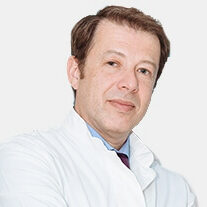
The author of the article
Boris Lipovetskiy, DMD, 31 years experience
Bruxism is a jaw disorder that often causes anxiety, stress, depression, and sleep problems. Many people do not notice it until the problem becomes serious. The danger of bruxism is that it is difficult to detect until complications arise. In this article, Dr. Lipovetskiy will discuss how to detect early signs of bruxism and how to get rid of it to live a healthy life.
What is Bruxism
Bruxism is a pathological condition in which a patient involuntarily clenches their jaws repeatedly. This occurs regardless of chewing or swallowing processes and is observed during nighttime. Clenching (pushing both jaws down on each other) can cause serious tooth injuries, even down to the root canal. Grinding (pushing both jaws left and right on top of each other) is also considered Bruxism, and can cause serious harm if not addressed as soon as possible.
Uncontrolled teeth grinding and clenching often manifests at night as bruxism. It occurs less frequently during the day – a condition referred to as bruxomania.
How does bruxism occur?
Bruxism is a paroxysmal tooth grinding. It arises from the spasm of the chewing muscles, strong clenching of the jaws, and their intense movement against each other.
Bruxism is usually your bodies response to a sleep disorder. For example, often patients have trouble breathing at night, and this results in their body subconsciously reacting by initiating teeth grinding and clenching. Hence, we highly recommend that the patient take a sleep test, and address the root cause of their bruxism. The process begins with the activation of the trigeminal nerve - responsible for the motor function and sensitivity of the face (contracts the chewing muscles). In bruxism, these muscles contract continuously or rhythmically, leading to the grinding of teeth against each other or tight clenching of the jaw.
The constant impact between the teeth can wear down enamel, cause chips or cracks, and increase sensitivity.
Symptoms of Bruxism
The primary symptom of the condition is uncontrolled teeth grinding, which persists for several seconds (within one episode). Other symptoms include:
- Morning headaches
- Dizziness
- Jaw and ear pain
- Chewing muscle spasms
- Discomfort when closing the mouth
- Increased sensitivity, cracks in tooth enamel
- Dry mouth
- Damage to the oral mucosa
- Insomnia, daytime drowsiness, and more
Often, bruxism goes unnoticed and is detected during examination by a dentist. If you’re a parent, you can detect signs of developing bruxism by assessing your child’s sleeping patterns. If the child is constantly twisting and turning, this could be a sign of a breathing disorder. Therefore, it is crucial not to neglect preventive check-ups with a specialist. If you suspect the development of this pathology, we recommend scheduling an appointment with a TMJ dentist.
What if bruxism is left untreated?
Chronic bruxism leads to enamel wear and chipping. In this case, treatment by a dentist will be ineffective: if the cause is not addressed, the problem will return. The patient's teeth will begin to decay and fall out.
Causes of Bruxism
-
Psychological
Approximately 75% of patients with increased anxiety and depressive states are diagnosed with parafunctions of the chewing muscles.
-
Occlusion
This refers to problems with the bite, temporomandibular joint disorders, defects in the dental arch, including partial edentulism.
-
Genetic
The likelihood of a child developing the disease is 50% higher if the condition has been diagnosed in their first-degree relatives.
-
Nervous system pathologies
Teeth grinding can be caused by head trauma (at birth), central nervous system damage, and others.
-
ENT diseases
Teeth grinding may occur in individuals with impaired nasal breathing due to a deviated nasal septum or frequent colds (rhinitis).
Types of Bruxism
There is no universally recognized classification of the disease. This is due to the complexity of the pathology. In practice, primary bruxism (not associated with other pathologies) and secondary bruxism (complication of the underlying disease) are distinguished.
Depending on the degree of progression of bruxism, forms of the pathology are identified:
- Initial. The patient does not notice any disturbances, does not complain of pain or discomfort, but there is a disruption in the function of the chewing muscles.
- Acute. The patient experiences sudden episodes of bruxism and jaw pain.
- Chronic. Episodes of sudden jaw clenching are frequent. They lead to complications such as chips and cracks in the teeth. Failure to seek timely medical attention may result in treatment for temporomandibular joint disorders.
In dentistry, bruxism classification based on the degree of tooth enamel wear of the patient is successfully applied:
- First degree. Enamel layer is slightly worn.
- Second degree. Enamel cusps and cutting edge are noticeably worn, dentin is exposed.
- Third degree. Enamel and dentin are worn down to the dental pulp.
In terms of prevalence, bruxism holds the esteemed third place, following dental caries and periodontitis. Official statistical data regarding the "popularity" of the disease are not objective because many patients are unaware that they are affected. Furthermore, the availability of precise diagnostic methods is very limited - traditionally, surveys are conducted (which are not sufficiently accurate).
Diagnostic Methods
The diagnosis of "bruxism" is based on data collected from a dental examination and the complaints of the patient and their relatives (regarding teeth grinding). During the examination, the specialist may detect wedge-shaped defects, visible defects in the enamel layer, and orthopedic appliances in the mouth, as well as mucosal injuries, and more. Palpation may reveal that the facial muscles of the patient are tense, and the patient may experience pain in the temporomandibular joint area.
Objective assessment of the disease is carried out using bruxism checkers. These are made from a personalized dental impression of the patient. Such caps help to detect occlusion pathologies (misalignment when closing the jaws). The device is worn at night, and the data collected are analyzed in dentistry to determine which teeth are under the most stress.
Among other methods of diagnosing teeth grinding are:
-
TENS (Transcutaneous Electrical Nerve Stimulation) diagnosis. Measuring the electrical activity of muscles. It determines how correctly and harmoniously the chewing muscles react to muscle stimulation.
-
Polysomnography. Recording brain activity and temporomandibular joint movements during the patient's sleep.
-
X-ray diagnostics (OPTG or CBCT) focusing on the study of paired temporomandibular joints.
-
Bruxometry. Using a bruxometer to record bruxism phenomena.
Treatment Methods for Bruxism
Regardless of the cause of bruxism, the treatment of the pathology begins with occlusion correction (achieving a physiologic closure of the upper and lower jaws) and ensuring an even distribution of chewing load on the muscles. Orthopedic instruments are used for this purpose, such as crowns to restore the height of the bite.
In our clinic, special ProSomnus caps are used for treating teeth grinding. They are worn at night, reducing the degree of jaw clenching. Regular use of individual devices helps relax the chewing muscles and alleviate pain in the localized area. The same effect is demonstrated by TENS therapy in the treatment of temporomandibular joint disorders in patients with bruxism. Sleep appliances such as a night guard can also be very beneficial in preventing teeth grinding. They can promote proper breathing patterns during sleep, as well as alleviate headings and pressure.
Simultaneously, pharmacotherapy is administered. Antidepressants are prescribed to normalize the psychoemotional background. Recommended medications also include muscle relaxants and anti-inflammatory drugs. Non-narcotic analgesics are prescribed for muscle pain. If necessary, a course of drugs aimed at treating neuroses is recommended.
Physiotherapy is also essential. This includes laser therapy, ultrasound, courses of magnetotherapy, and electronic neurostimulation. Some patients benefit from myogymnastics, which should be performed several times a day.
For severe cases of malocclusion that have led to the development of bruxism, surgical treatment may be necessary.
Dental implants can be placed in patients with bruxism. However, diagnosis and relaxation of the chewing muscles are needed first. Even after muscle tone correction, additional measures are taken to increase the strength of prostheses on implants.
Complications of Bruxism
In addition to the obvious negative consequence of the progression of bruxism – tooth wear – several other complications should be noted:
-
Temporomandibular joint disorders (TMJ)
This pathology develops as a result of localized muscle tension and causes pain, limited movement or jaw locking, migraines, tinnitus, and other unpleasant symptoms.
-
Breakage of prosthetic structures in the mouth
Due to uneven distribution of chewing load, installed crowns, bridges, and implants may become unusable and require replacement.
-
Orthodontic treatment difficulties
Braces fixed during orthodontic treatment are often damaged or detached due to bruxism. Effective correction of dental alignment without treating teeth grinding becomes impossible.
-
Rapid visual aging
The patient's teeth wear down, leading to a decrease in the dental arch and changes in facial proportions, resulting in deep wrinkles and facial asymmetry.
Can bruxism be eliminated forever?
Bruxism is a serious pathology that as of today we have no cure for. However, it is possible to reduce the manifestations of bruxism and prevent its complications. To do this, it is necessary to start treatment of the disease as early as possible. If you notice the initial signs of the pathology, make an appointment with our dental specialist.
Preventing Bruxism
Preventing bruxism involves adhering to measures that prevent the development of the disease. The main one is regular monitoring by a dentist and timely oral cavity sanitation (as indicated).
Bruxism is most commonly encountered by anxious individuals – those who regularly experience stress. To prevent the development of the disease, it is essential to react constructively to stress. We recommend finding and applying personal methods to relieve mental stress – such as meditation, breathing sessions, exercise, etc. During times of stress, it is highly desirable to identify the position of tightly clenched jaws and consciously relax them. It is also advisable to reduce the consumption of stimulants (caffeine, strong tea), alcoholic beverages, and try to quit smoking.
FAQ
Bruxism is more commonly observed in preschool-age children – approximately half of individuals under the age of 7 exhibit primary manifestations of the condition. Dentists consider this a normal phenomenon.
Among adults diagnosed with bruxism, it is more prevalent in individuals prone to depressive symptoms.



